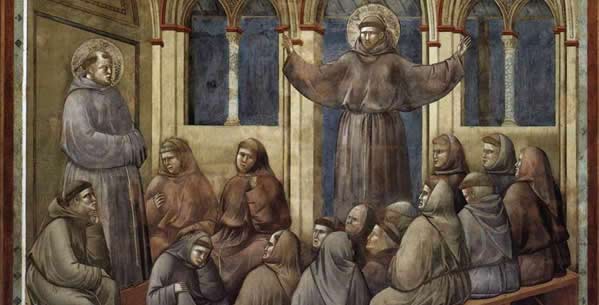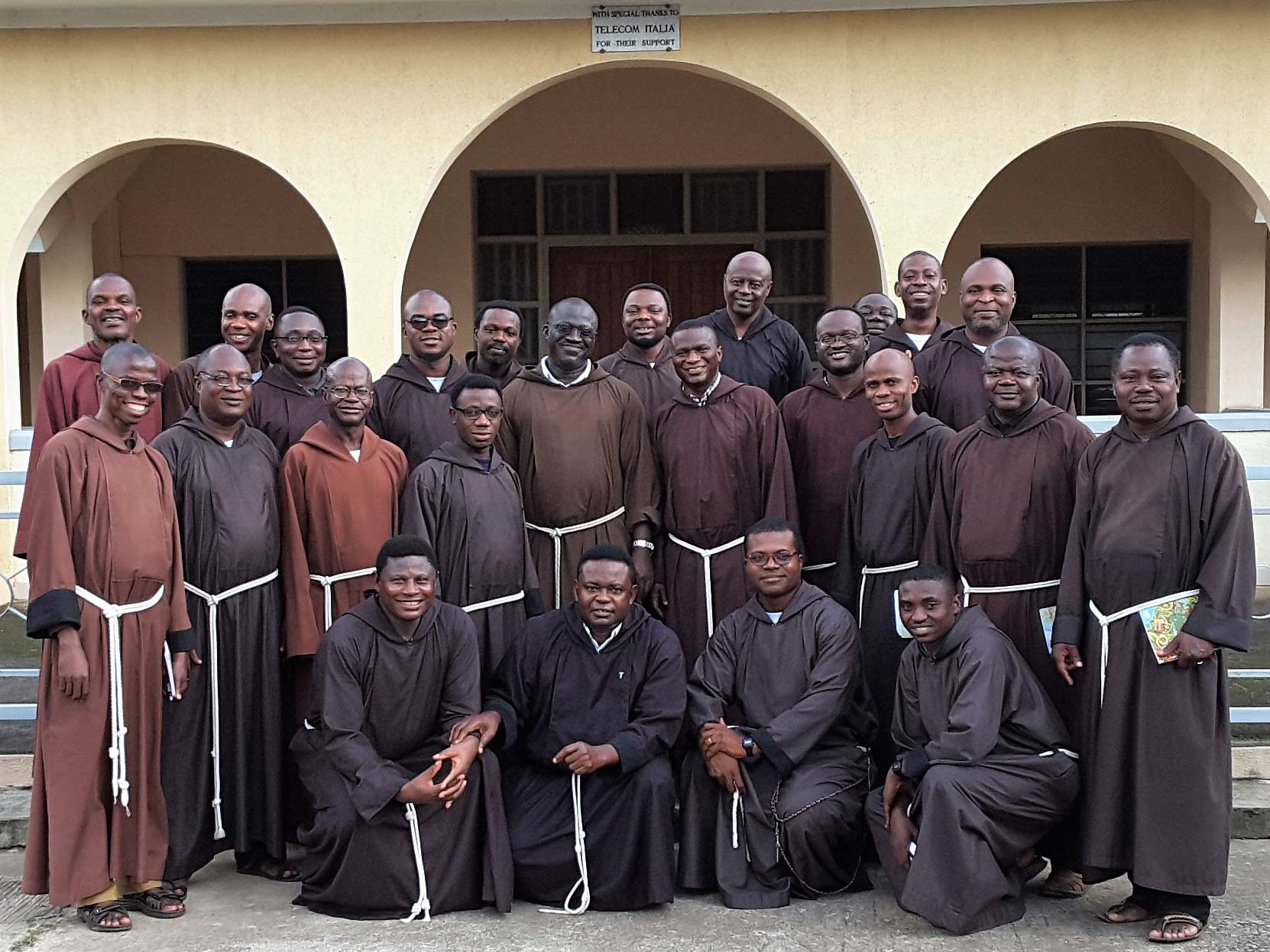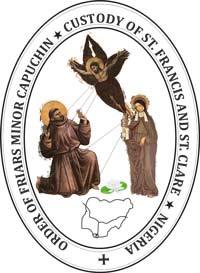ST. FRANCIS AND THE FRANCISCAN MOVEMENT

Francis was born in 1182 while his father, a rich cloth merchant, was away on a business trip in France. When he was baptised his mother named him John, but on returning his father renamed him Francis. He had a nice character and was very popular with the youths of Assisi. When he was 24 years old, a war broke out between Assisi and a neighbouring town, and Francis was taken prisoner. He was released after a year because he was sick.
It took him another year to recover from the illness, and when it was over Francis was a changed man. He had discovered God and prayed a lot, often seeking lonely places in the countryside around Assisi. One day he found a small abandoned Church, which was falling to ruin, and kneeling down he prayed in front of a wooden cross, which was still above the altar. Suddenly, the crucifix spoke to him and said, "Francis, go and repair my house, because as you see it is falling into ruin".
Francis took these words seriously, and sold all his belongings to get money to repair this small Church. His father was very annoyed with Francis' behaviour and dragged him in front of the Bishop of Assisi to convince his son to give back all his property. Francis had nothing left any more, so he took off his c1othes and gave them back to his father telling him: "I give you back all I have left, and even your name too. From now on I will no longer call you my father, but say Our Father who art in Heaven". With this Francis started living a life of poverty, following the Gospel in everything.
Soon God sent him his first companions. In 1209, when he had 11 companions, he set out to Rome to get approval of his group from the pope. Thus, the Order of Friars Minor was born. Besides this Order, he founded also the Second Order, the Poor Clares, for women when he accepted St. Clare; and another, The Secular Franciscan Order, for lay people who could not leave their families to live as religious.
The Order grew very rapidly. St. Anthony of Padua joined the Order at this time. Francis, however, still found time to seek lonely places to be alone with God in contemplation. By his example he was the model for Franciscan life: to alternate between times of prayer and apostolic activity. He saw God in all creation and considered all creatures as his brothers and sisters, calling the sun his brother and the moon and water his sisters. Even wild creatures submitted themselves to him and he was an instrument of peace among men.
The Franciscan movement brought many novelties in the Church. At a time when all religious were monks living stably in a monastery, the Franciscans became itinerants and became known also as Mendicants because they had a special permission to preach and beg for their living when their work was not enough to sustain them.
St Francis sought to give his life as Jesus himself did: to die as a martyr while preaching the Gospel. He did not succeed to die in this way, but managed to resemble Christ by sharing in his suffering. As a sign of this he became the first person to carry the wounds of Christ in his body, a stigmatist.
Francis died in 1226 at the age of 44. He died singing and praising God for everything even for Sister Death, as he called her.
THE CAPUCHIN REFORM

The phenomenal growth of the Franciscan Order made the observance of the Franciscan ideals, especially poverty, difficult as time went by. For this reason there have been several attempts to go back to the primitive poverty and simplicity of life of the origins. The result is three major reforms of the Franciscan Order, of which the Capuchins are the last.
The first big division of the Order came in 1517, when all the individual small reformed communities were grouped together as a separate Order. It was only 11 years later, however, that a third branch of Franciscans was born. It started very simply in 1525 through Friar Matthew of Bascio, who went to Rome and got a personal permission to live a life of poverty and live an itinerant life. It was not long, however, that many other friars wanted to join him. This marked the beginning of the Capuchin Order. The group obtained formal approval in 1528.
They were first known as the Friars Minor of eremitical life, because they lived in lonely places totally dedicated to prayer. Soon, however, they became known as Capuchins because of the shape of their hood. Gradually, they started accepting some forms of apostolate. The first was administering the last Sacraments to the sick who were stricken by plague -a terrible fatal disease at that time.
While maintaining their prayerful and secluded life, they were very much sought for Confessions. Some of the early Capuchins became also very good preachers, who knew how to unite sound doctrine and simplicity. Many people came to know them especially through the lay brothers, who used to beg humbly through the streets of many towns. The Order is today blessed with many saints.
CUSTODY OF NIGERIA

In the 17th Century, the Capuchins made unsuccessful attempts to establish their presence in Nigeria. They were then received by the Olu of Itsekiri and the Oba of Benin who expelled them from his kingdom to Sao Tome because of their opposition to his use of human beings for sacrifice.
But in the 20th Century, the Order came to stay in Nigeria by divine Providence. The life of Padre Pio of Pietrelcina inspired a young Nigerian, Akosa Emodi, who was undergoing his studies in the United States of America in 1979, to seek the way of the evangelical life of the Capuchin Franciscan Order. He joined the Mid America Province.
In the course of his novitiate, he experienced a growing urge to return and live the Capuchin Franciscan life in Nigeria. Not getting the assurance that he would be free to go back to Nigeria once he did his religious profession in the United States, he opted to return home and see if a Bishop from Nigeria could officially invite the Order to Nigeria.
Coming back home, he immediately met with and disclosed his burning zeal to embrace the way of life of the Capuchins, with a foundation in Nigeria, to the local ordinary of his diocese, the then Archbishop of Onitsha, Most Rev. Dr. Francis Arinze (now, Francis Cardinal Arinze). After two-month period of prayer and discernment, the Bishop, with his letter of August 20, 1982, formally wrote to invite the Capuchins to his diocese.
In response to the appeal of the General Minister, the Tuscan province graciously and courageously accepted the mission of implatatio ordinis in Nigeria. As a result, on March 12, 1984, Br. Giulio Galassi (of blessed memory) arrived Nigeria to begin this mission - being, in this way, the first Capuchin missionary in Nigeria in the modern times. On May 12, 1984, Br. Giulio was joined by br. Bernadino Faralli and Br. Mario Folli.
Till date, the Custody of Nigeria is still dependent on the Tuscan province. The earlier stages of initial formation in the earliest years of the Order in Nigeria were done in the mother province of Tuscany. From 1989 till date, all the stages of initial formation are done in Nigeria.
Presently the Capuchins have seven presences in six ecclesiastical jurisdictions in Nigeria - Onitsha, Enugu, Ibadan, Lagos, Benin and Uyo. Four of these seven houses are primarily dedicated to initial formation, and three to works of the apostolate.


